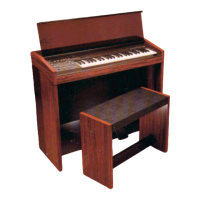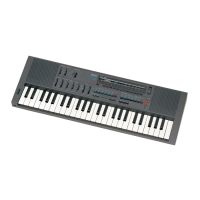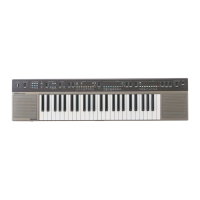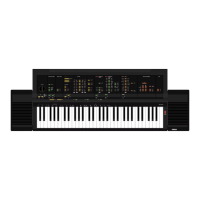Editing a Voice
81
Owner’s Manual
Quick Guide — Advanced Course
Editing a Voice by using the Knobs
The four knobs at the top left of the instrument are not only for tweaking the sound while you perform — you can also use
them to edit a Voice, either in the Voice Play mode or the Voice Edit mode.
● When the [PAN/SEND] indicator is turned on:
● When the [TONE] indicator is turned on:
n The settings above are applied as offsets to the AEG and FEG settings in the Voice Edit mode.
● When the [ARP FX] indicator is turned on:
● When the [EQ] indicator is turned on:
n The settings above are applied as offsets to the EQ settings in the [VOICE] → [UTILITY] → [F3] VOICE → [SF1] MEQ display.
● When both the [PAN/SEND] and [TONE] indicators are turned on (by pressing them simultaneously):
n In addition to above functions, Master Effect related parameters (set in the [UTILITY] → [F3] VOICE → [SF2] MEF display) can be assigned to
these four knobs by pressing the [ARP FX] and [EQ] buttons simultaneously. The particular parameters assigned to the four knobs can be set in the
[UTILITY] → [F4] CTL ASN → [SF5] MEF display.
Editing a Voice by using the Control Sliders (CS)
In the Voice mode, the four Control Sliders let you independently adjust the levels of the Elements of a Normal Voice or the
Drum Voice keys. When a Normal Voice is selected, you can adjust the level balance among the four Elements.
n Inadvertent use of the sliders may result in no sound. If this occurs, move the sliders upward.
PAN Determines the stereo pan position of the Voice. [VOICE] → Voice selection → [EDIT] → [COMMON] →
[F2] OUTPUT → Pan
Page 190
REVERB Determines the amount of Reverb effect that is applied to the Voice. [VOICE] → Voice selection → [EDIT] → [COMMON] →
[F2] OUTPUT → RevSend
Page 191
CHORUS Determines the amount of Chorus effect that is applied to the Voice. [VOICE] → Voice selection → [EDIT] → [COMMON] →
[F2] OUTPUT → ChoSend
Page 191
TEMPO
Determines the tempo of the Arpeggio assigned to the currently selected Voice.
[VOICE] → Voice selection → [F6] ARP → Tempo Page 189
CUTOFF Raises or lowers the Filter cutoff frequency to adjust the tone brilliance. [VOICE] → Voice selection → [F5] EG → CUTOF Page 189
RESONANCE Boosts or attenuates the level at the area around the Filter cutoff
frequency.
[VOICE] → Voice selection → [F5] EG → RESO Page 189
ATTACK Determines the attack time of the sound. For example, you can adjust a
strings Voice so that the sound gradually swells in volume by setting a
slow attack time – simply turn this knob to the right.
[VOICE] → Voice selection → [F5] EG → ATK (AEG) Page 189
RELEASE Determines the release time of the sound. Turning the knob to the right
sets a long release time and (depending on the selected Voice) lets the
sound sustain after the key is released. To produce a sharp release, in
which the sound abruptly cuts off, set a short release time.
[VOICE] → Voice selection → [F5] EG → REL (AEG) Page 189
SWING Adjusts the swing feel of the Arpeggio playback. [VOICE] → Voice selection → [EDIT] → [COMMON] →
[F3] ARP → [SF3] PLAY FX → Swing
Page 192
GATE TIME Adjusts the Gate Time (length) of the Arpeggio notes. [VOICE] → Voice selection → [EDIT] → [COMMON] →
[F3] ARP → [SF3] PLAY FX → GateTimeRate
Page 192
VELOCITY Adjusts the velocity of the Arpeggio notes. [VOICE] → Voice selection → [EDIT] → [COMMON] →
[F3] ARP → [SF3] PLAY FX → VelocityRate
Page 192
UNITMULTIPLY Adjusts the Arpeggio playback time based on tempo. [VOICE] → Voice selection → [EDIT] → [COMMON] →
[F3] ARP → [SF3] PLAY FX → UnitMultiply
Page 192
LO Determines the amount of boost or attenuation applied to the low
frequency band of the Master EQ.
[VOICE] → Voice selection → [EDIT] → [COMMON] →
[F1] GENERAL → [SF3] MEQ OFS → LOW
Page 190
LO MID Determines the amount of boost or attenuation applied to the low-
midrange frequency band of the Master EQ.
[VOICE] → Voice selection → [EDIT] → [COMMON] →
[F1] GENERAL → [SF3] MEQ OFS → LOW MID
Page 190
HI MID Determines the amount of boost or attenuation applied to the high-
midrange frequency band of the Master EQ.
[VOICE] → Voice selection → [EDIT] → [COMMON] →
[F1] GENERAL → [SF3] MEQ OFS → HIGH MID
Page 190
HI Determines the amount of boost or attenuation applied to the high
frequency band of the Master EQ.
[VOICE] → Voice selection → [EDIT] → [COMMON] →
[F1] GENERAL → [SF3] MEQ OFS → HIGH
Page 190
ASSIGN A Adjusts parameters assigned to these knobs in the [UTILITY] → [F4] CTL ASN → [SF2] ASSIGN display. Page 263
ASSIGN B
ASSIGN 1 Adjusts parameters assigned to these knobs in the [VOICE] → Voice selection → [EDIT] → [COMMON] → [F4] CTL SET display. Page 192
ASSIGN 2
[VOICE] → Voice selection → [EDIT] → Element selection → [F4] AMP → [SF1] LVL/PAN → Level

